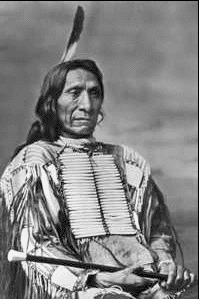|
|
Red Cloud
Makhpiya-Luta
(1822-1909)

As a warrior and a statesman, Red Cloud's success in confrontations with the United States government marked him as one of the most important Lakota leaders of the nineteenth century.
Although the details of his early life are unclear, Red Cloud was born near the forks of the Platte River, near what is now North Platte, Nebraska. His mother was an Oglala and his father, who died in Red Cloud's youth, was a Brul Red Cloud was raised in the household of his maternal uncle, Chief Smoke.
Much of Red Cloud's early life was spent at war, first and most often against the neighboring Pawnee and Crow , at times against other Oglala. In 1841 he killed one of his uncle's primary rivals, an event which divided the Oglala for the next fifty years. He gained enormous prominence within the Lakota nation for his leadership in territorial wars against the Pawnees, Crows, Utes and Shoshones .
Beginning in 1866, Red Cloud orchestrated the most successful war against the United States ever fought by an Indian nation. The army had begun to construct forts along the Bozeman Trail, which ran through the heart of Lakota territory in present-day Wyoming to the Montana gold fields from Colorado's South Platte River. As caravans of miners and settlers began to cross the Lakota's land, Red Cloud was haunted by the vision of Minnesota's expulsion of the Eastern Lakota in 1862 and 1863. So he launched a series of assaults on the forts, most notably the crushing defeat of Lieutenant Colonel William Fetterman's column of eighty men just outside Fort Phil Kearny, Wyoming, in December of 1866. The garrisons were kept in a state of exhausting fear of further attacks through the rest of the winter.
Red Cloud's strategies were so successful that by 1868 the United States government had agreed to the Fort Laramie Treaty . The treaty's remarkable provisions mandated that the United States abandon its forts along the Bozeman Trail and guarantee the Lakota their possession of what is now the Western half of South Dakota, including the Black Hills, along with much of Montana and Wyoming.
The peace, of course, did not last. Custer's 1874 Black Hills expedition again brought war to the northern Plains, a war that would mean the end of independent Indian nations. For reasons which are not entirely clear, Red Cloud did not join Crazy Horse , Sitting Bull and other war leaders in the Lakota War of 1876-77. However, after the military defeat of the Lakota nation, Red Cloud continued to fight for the needs and autonomy of his people, even if in less obvious or dramatic ways than waging war.
Throughout the 1880's Red Cloud struggled with Pine Ridge Indian Agent Valentine McGillycuddy over the distribution of government food and supplies and the control of the Indian police force. He was eventually successful in securing McGillycuddy's dismissal. Red Cloud cultivated contacts with sympathetic Eastern reformers, especially Thomas A. Bland, and was not above pretending for political effect to be more acculturated to white ways than he actually was.
Fearing the Army's presence on his reservation, Red Cloud refrained from endorsing the Ghost Dance movement, and unlike Sitting Bull and Big Foot , he escaped the Army's occupation unscathed. Thereafter he continued to fight to preserve the authority of chiefs such as himself, opposed leasing Lakota lands to whites, and vainly fought allotment of Indian reservations into individual tracts under the 1887 Dawes Act . He died in 1909, but his long and complex life endures as testimony to the variety of ways in which Indians resisted their conquest.
|
|
|
|
|
 Native American Nations
Native American Nations
